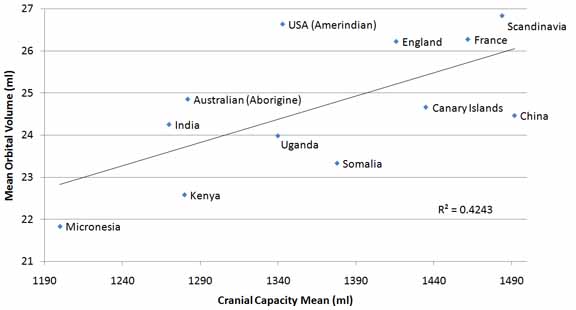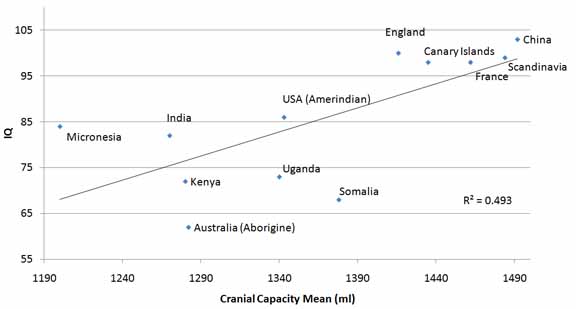Eye Size, Brain Size, and Intelligence
Henry Wolff, American Renaissance, September 2011
A study by scientists at Oxford University has shown a significant positive relationship between cranial capacity, orbital (eye socket) volume, and the geographical latitude at which different groups evolved. The study of 55 skulls from 12 populations found that these correlations held even after controlling for body size. The authors argue that lower ambient light levels at higher absolute latitudes (north or south) led to increased orbital volume and larger eyes, which may help people see better in low light.
Bigger eyes led to larger visual cortices, where vision is processed in the brain. It has long been known that humans who evolved at high latitudes have bigger brains than those who evolved closer to the equator. The researchers say these brains are larger because of larger visual cortices.
Speaking to BBC News, lead author Eiluned Pearce said, “[W]e argue that having bigger brains doesn’t mean that high-latitude humans are necessarily smarter. It’s just they need bigger eyes and brains to be able to see well where they live.” The study did not look into the connection between big eyes, visual cortex size, and night vision, but the authors told the BBC that in the future they plan to “establish a firm link between eyeball size and enhanced visual processing areas in the brain.”
The Oxford team’s data are in Table 1. The researchers found that Chinese skulls had the largest cranial capacity (1492 ml), followed by those from Scandinavia (1484 ml). The lowest average capacities came from Micronesia (1200 ml) and India (1270 ml).
| Table 1 (skulls in order of ascending latitude) | |||
| Country | Latitude | Mean orbital volume (ml) |
Mean cranial capacity (ml) |
|---|---|---|---|
| Kenya | 0.02 | 22.58 | 1280 |
| Uganda | 1.36 | 23.98 | 1340 |
| Micronesia | 4.06 | 21.83 | 1200 |
| Somalia | 10.1 | 23.33 | 1378 |
| India | 17.63 | 24.25 | 1270 |
| Australia | 22.89 | 24.85 | 1282 |
| Canary Islands | 28.51 | 24.66 | 1435 |
| China | 37.37 | 24.46 | 1492 |
| USA (Amerind) | 40.74 | 26.63 | 1343 |
| France | 47.65 | 26.27 | 1462 |
| England | 51.9 | 26.22 | 1416 |
| Scandinavia | 64.21 | 26.83 | 1484 |
There is a strong correlation (r2 = 0.817) between latitude and orbital volume. There is also a moderate correlation (r2 = 0.424) between orbital volume and cranial capacity (see Figure 1), which led the researchers to conclude that it is the larger visual cortices that increase the size of brains that evolved at high latitudes.
One different and probably complementary explanation for larger brains at higher latitudes is greater intelligence, a possibility the Oxford team seems to have dismissed. J. Philippe Rushton and C. Davison Ankney reviewed a total of 381 adult samples from seven MRI studies and one CAT-scan study that related brain size to intelligence, which was measured by standardized tests or estimated by education and occupation. The results were a moderate average correlation of 0.44 that declined to 0.42 when weighted by sample size.

To further test the hypothesis that higher intelligence at least partly accounts for increased brain size, I compared national IQ data to the measured cranial capacities in the Oxford study (see Figure 2). The correlation (r2 = 0.493) is higher than the 0.424 correlation between orbital volume and cranial capacity, which suggests that increased visual cortex volume alone does not account for increased brain size.

The data on the Chinese skulls are particularly interesting. The skulls come from relatively low latitudes and were only about average in mean orbital volume, yet they had the largest average cranial capacity. Clearly, it is not large eyes alone that lead to increased brain size. At the same time, the Chinese have the highest average IQ, suggesting that brain size is more closely associated with intelligence than it is with orbital volume.
I do not doubt the Oxford findings that evolution in higher latitudes led to bigger eyes, and even to bigger visual cortices. It may even be that people from high latitudes really do see better in the dark, but it is surprising that we have never heard about this before. However, the team’s curious unwillingness to consider the association between IQ differences and brain size deprived it of what appears to be an important explanation for their findings.
References
Pearce, E. & Dunbar, R. (2011). Latitudinal Variation in Light Levels Drives Human Visual System Size. Biology Letters. Published online before print.
Rushton, J. P. & Ankney, C. D. (1996). Brain Size and Cognitive Ability: Correlations with Age, Sex, Social Class, and Race.Psychonomic Bulletin & Review, 3, 21-26.
Lynn, R. Race Differences in Intelligence. Washington Summit Publishers, 2006.
Lynn, R. & Vanhanen, T. IQ & Global Inequality. Washington Summit Publishers, 2006.
[Editor’s Note: This article first appeared in the September 2011 issue of American Renaissance.]















